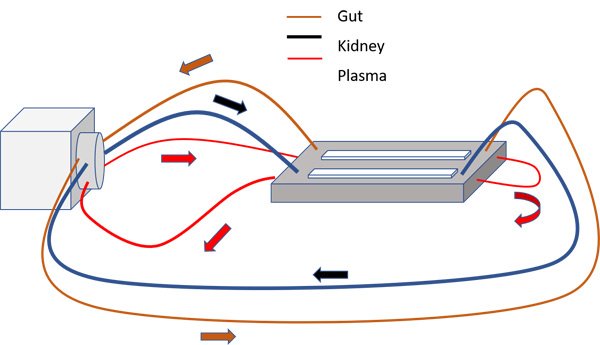New miniature system to study kidney and intestine function
When pharmacology and theoretical physics meet
Researchers at Utrecht University developed a new organ-on-a-chip: a device to mimic and study kidneys and intestines in miniature format. The device is the result of a special collaboration between pharmacology and theoretical physics, which significantly improved the fluid flows in the device. The researchers are publishing their findings 24 July in Frontiers in Bioengineering and Biotechnology.
The chip has been adapted in such a way that we can simulate fluid flows as real as possible.
"In this research we made a chip that enables us to mimic the kidney and the intestines in miniature and study the effects of substances on these organs", says Professor of Experimental Pharmacology Roos Masereeuw. Fluid flows, such as blood, influence the development and functioning of cells in these devices. "We just didn't know how much flow was needed for proper development and whether this was as close as possible to reality. Based on the calculations of René van Roij's research group, the chip has been adapted in such a way that we can simulate fluid flows as real as possible."

The miniature system for gut and kidney consists of a tube in a container through which water flows. Cells are placed on the tube, which ideally grow into a dense, homogeneous layer of specific kidney or intestinal cells, influenced by the pressure of the fluid that mimics blood flow.
This brings pre-clinical in vitro testing of drugs dispositions in an animal-free manner one step closer.
"Thanks to our theoretical calculations, we have a much better idea of which channel geometry is optimal, such as the shape of the device, the location of input and output, the location of the tube in the chip", says physicist René van Roij, Professor Theory of Soft Matter. "Now we also know better at what rate to pump the fluid peristaltically to generate a nice layer of well-developed kidney or intestinal cells in vitro. In the modified device, we observed a better layer formation and improved cell development. This brings pre-clinical in vitro testing of drugs dispositions in an animal-free manner one step closer."
Serendipity
The fact that the chip approximates reality is due to the cooperation between the two very different research areas. "This was only possible thanks to the combination of our two areas of expertise”, says Roos Masereeuw. That collaboration came about by chance. "Pure serendipity!", says Van Roij. "During the Academic Year Opening I happened to sit next to Roos. We met, and when she heard that I am a physicist, she asked if I knew someone in my department who is an expert on fluid flow and microfluidics. Well, that was me." Master student of theoretical physics Nicky Langerak then calculated and modelled the organ-on-a-chip device for a year, in close collaboration with Haysam Ahmed, postdoc in the pharmacology group, who tested its performance.
"We now have a model we can use in a follow-up project in which we link the intestine to the kidney”, says Masereeuw. "In that project, we're going to model kidney disease and study how it can affect the functioning of the intestine."
Publication
A theoretical and experimental study to optimize cell differentiation in a novel intestinal chip. Frontiers in Bioengineering and Biotechnology, 24 July 2020. Nicky Langerak*, Haysam M. Ahmed*, Igor R. Middel*, Yang Li*, Hossein Eslami Amirabadi*, Jos Malda*, Rosalinde (Roos) Masereeuw*, René van Roij* DOI: 10.3389/fbioe.2020.00763
*Affiliated with Utrecht University

